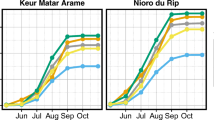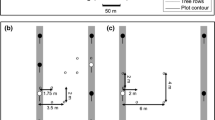Abstract
In Italy, new agroforestry cultural models could play an important role in the diffusion of plantation forestry timber species. We studied the stem growth rates and leaf water potentials (Ψ) of common walnut (Juglans regia L.), and gravimetric soil moisture (θDW) depletion during the third and fourth growing seasons in an agroforestry trial in central Italy. Since the establishment of experimental plots in 1992, walnut was intercropped with alfalfa (Medicago sativa L.), with or without polyethylene (PE) mulching along tree rows. By the end of the study period, the unmulched-intercropped walnut was almost 68% smaller in stem diameter and height than the sole-unmulched control, demonstrating walnut’s sensitivity to alfalfa competition. The competitive effect of alfalfa on walnut stem growth was effectively controlled/reduced by PE mulching. Stem growth rates of mulched-intercropped walnut were always lower than the control, but much higher (ca. 235% in stem diameter and height) than those of unmulched-intercropped walnut. The higher field performance of mulched-intercropped walnut compared to the un- mulched-intercropped treatment was associated with higher soil moisture and predawn and midday Ψ values during the summer’s driest periods. The presence of PE mulching was also associated with lower levels of soil moisture during the early and late growing season, but this did not negatively affect walnut Ψ and growth rates. These results suggest that in the climatic conditions of central Italy, competition for soil moisture between young common walnut trees and alfalfa can be substantially lowered, but not completely eliminated, by PE mulching.
Similar content being viewed by others
References
Baldy C, Dupraz C and Schillizzi S (1993) Vers de nouvelles agroforesteries en climats tempérés et méditerranéens. I. Aspects agronomiques. Cahiers Agricultures 2: 4–14
Buresti E (1996) Modelli colturali per il noce da legno. Sherwood 15: 27–32
Carruthers SP (1987) Prospects for European Agroforestry. Span 30: 7–8
Davies RJ (1988) Sheet mulching as an aid to broadleaved tree establishment. I. The effectiveness of various synthetic sheets compared. J Forestry 61: 89–105
Dupraz C (1994) Prospects for easing land tenure conflicts with agroforestry in Mediterranean France: a research approach for intercropped timber orchards. Agrofor Syst 25: 181–192
Dupraz C, Dauzat M, Girardin N and Olivier A (1995) Root extension of young wide-spaced wild cherry trees in an agroforest as deduced from the water budget. In: Ehrenreich JH, Ehrenreich DL and Lee HW (eds) Growing a Sustainable Future, Proceedings of the 4th North-American Agroforestry Conference, pp 46–50. Boise, Idaho, USA, July 1995
Dupraz C and Newman S (1997) Temperate agroforestry: The European Way. In: Gordon AM and Newman SM (eds) Temperate Agroforestry Systems, pp 181–236. Cab International, Oxon, UK
Garrett HE, Jones JE, Kurtz WB and Slusher JP (1991) Black Walnut Integrated Forestry-Farming — A case History. In: William PA (ed) Proceedings of First Conference on Agroforestry in North America, pp 15–27, August 1989, Guelph, Ontario, Canada
Gold MA and Hanover JW (1987) Agroforestry systems for the temperate zones. Agrofor Syst 5: 109–121
Gordon AM and Williams PA (1991) Intercropping valuable harwood tree species and agricultural crops in southern Ontario. For Chron 67: 200–208
Jay-Allemand C, Fady B and Becquey J (1996) Walnut trees for woodland use in mediterranean countries: current situation and prospects. FAO-Nucis-Newsletter 5: 10–13.
Mariano A e Sperandio G (1994) Primi risultati di prove di pacciamatura in piantagioni forestali. Monti e Boschi 2: 42–48
McDonald PM and Helgerson OT (1990) Mulches aid in regenerating California and Oregon forests: past, present and future. USDA Forest Service, General Technical Report PSW-123. Pacific Southwest Research Station, Berkeley, California, USA
Nahal I (1981) The Mediterranean Climate from a biological viewpoint. In: Di Castri F, Goodal DW and Specht RL (eds.) Mediterranean-type Shrublands, pp. 63–86. Elsevier Scientific Publ, New York, USA
Nambiar EKS and Sands R (1993) Competition for water and nutrients in forests. Can J For Res 23: 1955–1968
Newman SM and Gordon AM (1997) Temperate agroforestry: synthesis and future directions. In: Gordon AM and Newman SM (eds) Temperate Agroforestry Systems, pp 251–266. Cab International, Oxon, UK
Paris P e Cannata F (1991) L'agroselvicoltura: una moderna realtà dei Paesi industrializzati e di quelli emergenti. Monti e Boschi 2: 21–27
Paris P, Cannata F and Olimpieri G (1995) Influence of alfalfa (Medicago sativa L.) intercropping and polyethylene mulching on early growth of walnut (Juglans spp.) in central Italy. Agrofor Syst 31: 169–180
Piccini C e Sperandio G (1996) Primi risultati di una prova di pacciamatura e diserbo in piantagioni di Juglans regia L. Linea Ecologica-Economia Montana 3: 46–51
Pini R, Benetti A and Vigna Guidi G (1994) Soil physical characteristics in an Italian walnut plantation under different cultural models. First General Meeting of European Commission Project AIR CT92 0142, Orleans, France, March 1994
Ritchie GA and Hinckley TM (1975) The pressure chamber as an instrument for ecological research. In: MacFadyen A (ed.) Advances in Ecological Research, Vol 9, pp 166–243, Academic Press, London, UK
Scholander PF, Hammel HT, Bradstreet ED and Hemmingsen EA (1965) Sap pressure in plants. Science 149: 920–922
Turner C (1988) Measurement of Plant Water Status by the pressure chamber technique. Irrigation Science 9: 289–300
Traux B and Gagnon D (1993) Effects of straw and black plastic mulching on the initial growth and nutrition of butternut, white ash and bur oak. Forest Ecology and Management 17: 159–167
United States Department of Agriculture (USDA) (1975) Soil Taxonomy. Agriculture Handbook No. 436. Washington, DC, USA, 753 pp
Walker RF and McLaughlin SB (1989) Black polyethylene mulch improves growth of plantation-grown loblolly pine and yellow-poplar. New Forests 3: 265–274
Williams PA and Gordon AM (1992) The potential of intercropping as an alternative land use system in temperate North America. Agrofor Syst 10: 253–263
Williams PA and Gordon AM (1995) Microclimate and soil moisture effects of three intercrops on the rows of a newly-planted intercropped plantation. Agrofor Syst 29: 285–302
Author information
Authors and Affiliations
Corresponding author
Rights and permissions
About this article
Cite this article
Paris, P., Olimpieri, G., Todaro, L. et al. Leaf-water potential and soil-water depletion of walnut mulched with polyethylene and intercropped with alfalfa in Central Italy. Agroforestry Systems 40, 69–81 (1998). https://doi.org/10.1023/A:1006079215567
Published:
Issue Date:
DOI: https://doi.org/10.1023/A:1006079215567




